Little is more frustrating to well-meaning nonprofits than having emails land in a junk folder. What can you do to ensure you'll stay in the safe zone? Read our guide to learn everything you need to know about getting your emails where they belong.

Every time we talk about email deliverability, it's easy to envision a video game. What starts as an innocent little nonprofit email finds peril at every turn! To get to the hallowed ground of 100% deliverability, you must set up protective feedback loops and dodge spam traps. Clean up your reputation! Choose the right domain! And if you play the game really well, your email lands in an inbox, with trumpets trumpeting and unicorns flying.
That’s a bit dramatic, and it’s also not really that hard to avoid the spam folder. What it takes is a partnership between you, the CharityEngine client, and our team. Our clients enjoy email deliverability north of 99%, so we are certain we can get you to the land of rainbows and sparkles.
There’s a caveat: we can’t do it without you. There’s a lot our team does to ensure great deliverability, but there’s a checklist of things that only you, the client, can control.
Let’s start at the beginning with a clear definition of what we’re talking about. When you send mass emails, there are a lot of factors that can mark your emails as spam. Sometimes they’ll go right to a spam folder and your recipients won’t see them. Sometimes they’ll go to a promotions or social folder, which is one step up from spam, and get mass deleted along with the 254 other promotional emails selling makeup and golf lessons.
The only place you ever want your emails to go is right to the inbox of whomever the recipient is.

In this article, we will cover:
This quick guide will offer all our email deliverability best practices, outline exactly what’s required of you and us, and serve as a resource that will keep your emails in tip-top, non-spammy shape.
We've got you covered! This article will give you step-by-step instructions and will prove to you that staying out of the spam folder isn't a lot of hocus pocus.
You might think that it’s not a big deal if your emails sometimes go to spam. But it’s actually a huge deal! If your emails are marked as spam, here are some of the problems you will find:
CharityEngine recommends that new clients audit their lists carefully, looking at the data to see who has engaged with their communications. A best practice is to send to contacts who have viewed or clicked on one of your emails within the last year. Begin to filter out those contacts that have not engaged year after year. Once you have a healthy list, you’re a step closer to a healthy reputation.
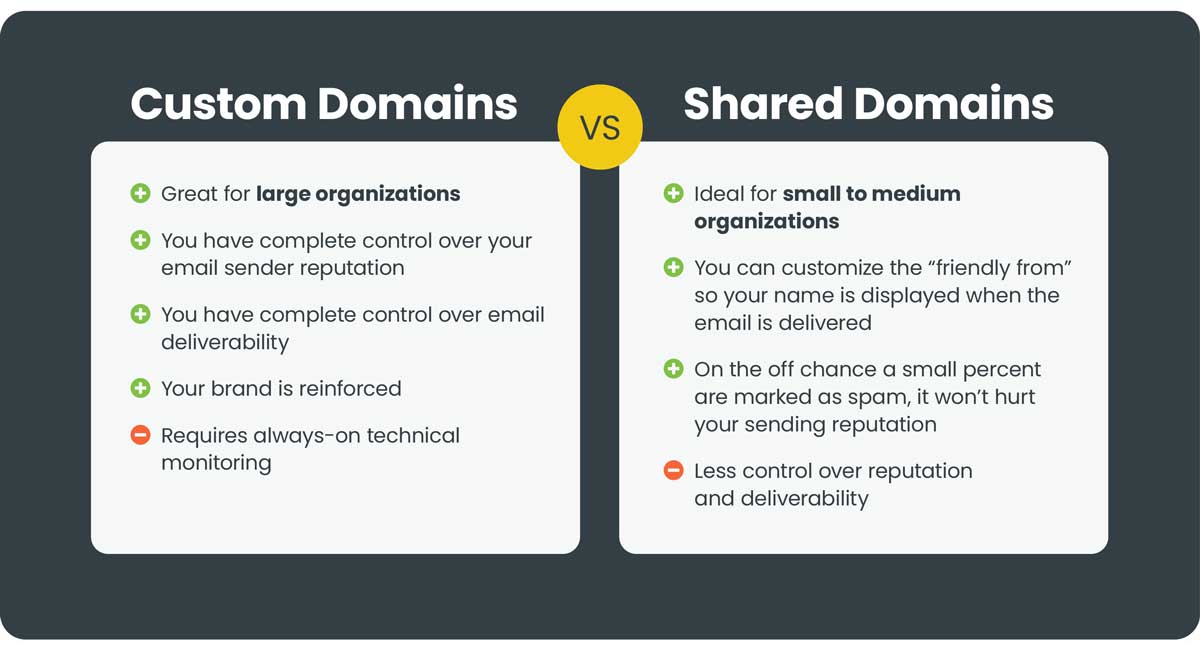
There are two options for domains and IP addresses:
1. You can have a custom domain, such as www.yourorg.com, and emails from you@youorg.com will offer authority and brand recognition.
The pros of a custom domain?
Therein lies a caution. Having complete control over your email sender reputation and email deliverability means always-on technical monitoring. If you have a large IT department, this might be doable.
2. A shared pool is one designed for senders who do not have high volumes of mail or the IT resources to manage a private domain. IP addresses are grouped together, and mail is sent in bulk to avoid spam labels.
The pros of a shared pool?
In general, small to midsize nonprofits benefit from a shared pool, and our enterprise-level clients often have the resources to choose a custom domain.
Another tactic used by receiving domains is to employ spam traps. These are email addresses created with certain characteristics for the sole purpose of catching spam emails.
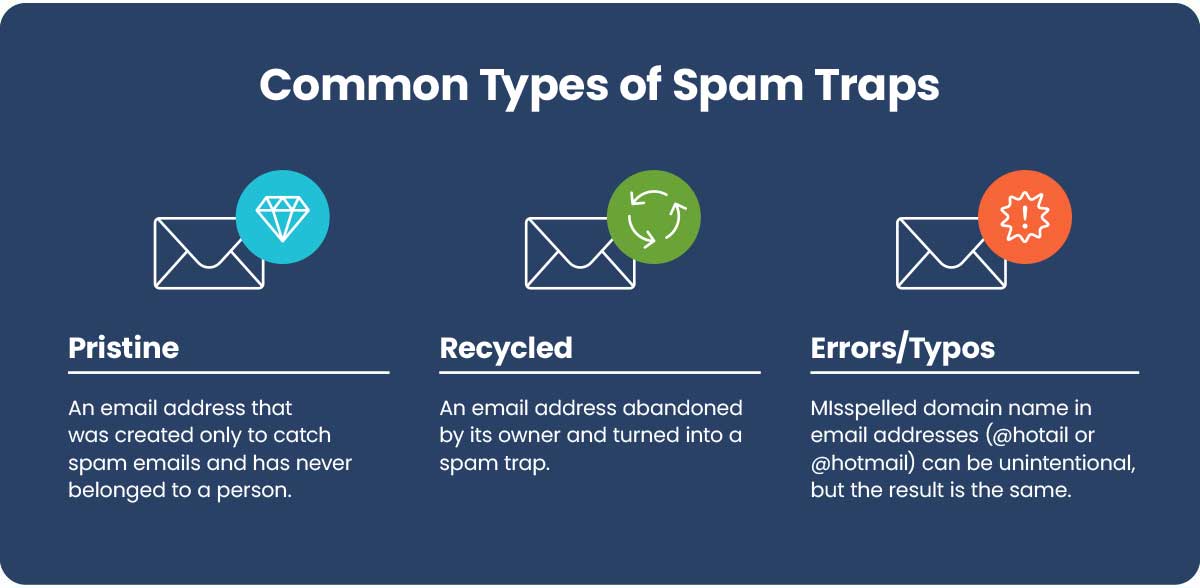
There are two types of spam traps and a third technique that behaves like a spam trap.
They’re designed to be unrecognizable, but there are some warning signs:
 The bottom line?
The bottom line?
Data hygiene. Clean your email list, keep monitoring it, and ensure it’s comprised of legit, opted-in recipients. As your list is growing, pay attention to the users and make sure you’re not inadvertently introducing emails that aren’t attached to an actual person.
If you’re purchasing a big list, the easiest way to get started is to run it through a provider of those services, such as ZeroBounce or NeverBounce, to see if the emails are valid. It’s not 100% accurate, but it can identify spam traps or emails with misspellings. Once the program identifies the valid addresses, it’s up to you to refine the list in your database to eliminate those invalid email addresses.
Your list will undoubtedly grow, and it is important that your technology monitors email addresses as they’re entered and flags those that might not be valid. Ongoing data hygiene and list maintenance—actively monitoring and cleaning your list—is easier than a steady diet of fires you need to extinguish as your reputation tanks.
When you have new dedicated domains and IP addresses, it’s important that you establish your reputation. The way to do this is through domain and IP warming. You begin by sending a small volume of emails (perhaps 10% of your overall send, but check with your IT department or us to help you with a strategic schedule) and then gradually, over several days or weeks, add on 20% or 30% volume until your domain and IP addresses are established.
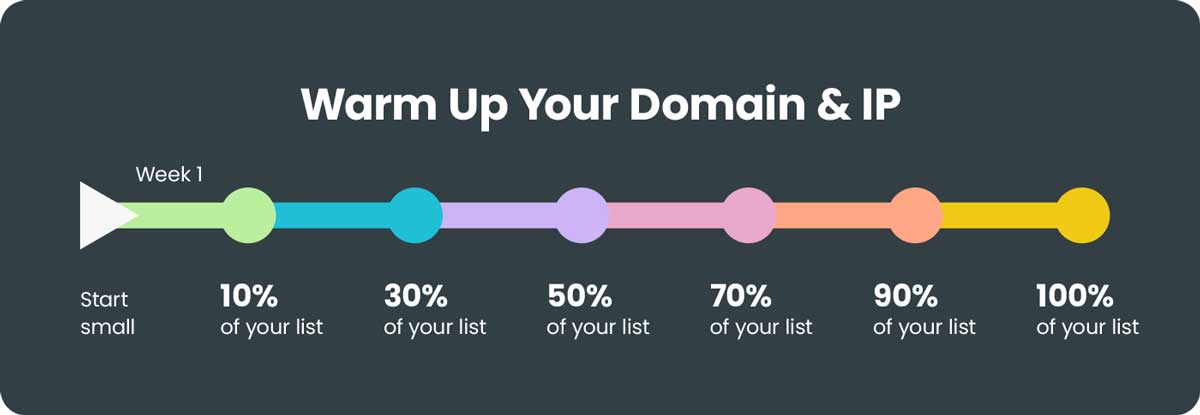
Talk to the receiving service provider as you warm your domain and IP addresses. If there are any warning signs, you can quickly remedy the issues.
What if there’s one service provider that keeps marking your emails as spam? Talk to them, but start over with the IP warming. Throttle your emails and go slowly to rebuild your reputation.
If a new domain sends tons of emails in bulk right off the bat, the receiving servers will immediately question your validity, and your emails are at risk of being labeled spam. If you warm your domain and IP addresses and establish a good reputation, you’ll find your email deliverability rates will be pretty high.
CharityEngine's CRM offers the ability to pace your emails for you, even if you segment your list and start a slow send. You’ll still want to pay attention to the receiving domain, which might ask you to take a break from sending or slow it down.
Here’s a tip: put your most ardent supporters in your warm-up sends. You want to ensure they get your communication, and you are likely confident they will open the email and/or otherwise engage, which helps your deliverability and reputation.
In general, it’s important to know that receiving domains, like Gmail and Microsoft, are establishing reputations for each IP sending address. If you are classified as a “bad sender,” your emails are likely going to spam, and the receiving domains can even block the emails and delay them significantly or return them as undeliverable. All of these outcomes can significantly hurt your brand and your fundraising efforts.
It’s really easy to hurt your reputation quickly, and really difficult and time-consuming to build it back. Our advice is to start strong, with clean lists, and then focus on building and keeping a sterling reputation. If you’re monitoring it closely, you’ll be nimble and able to react if there’s a dip or decline and fix things before your reputation takes a hit.
High email deliverability takes two of us. There are very clear tasks that clients must accept responsibility for and monitor carefully.
Let’s take a look at each of these.
Answer these questions about every single person on your list:
Now let’s talk about the actual email content you’re sending. Here are our tried-and-true, best tips for nonprofit emails:
When you hit “send,” two different technologies combine to form DMARC (Domain-based Message Authenticated Reporting and Conformance), which authenticates the email coming from your domain. DMARC reports ensure your sending domain, and the message you’re sending, are both legitimate.
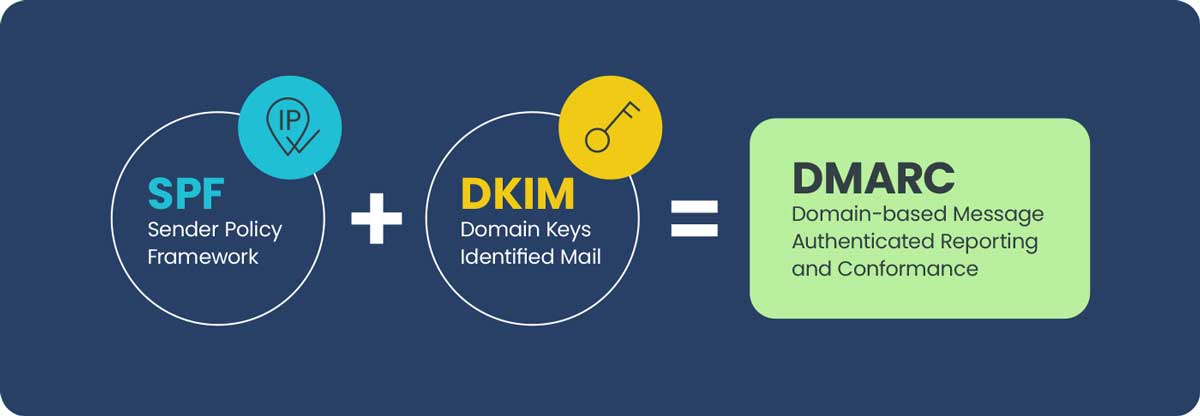
The two building blocks of DMARC are SPF (Sender Policy Framework) and DKIM (Domain Keys Identified Mail). While this is a little more technical than you might want, SPF is basically a whitelisting of IP addresses aligned with a particular sending domain. The receiving domains, or the domains of the recipients of your emails, are going to run your IP address against that list and make sure it’s included and verified.
DKIM sets up a digital signature that accompanies the emails you send. This is another thing the receiving domains will look for to authenticate your emails.
DMARC looks to see if your IP address is on the list (SPF) and if the digital signature is present (DKIM). If one is missing, your email can be labeled as spam.
How can you manage these records? On the sending side, set up a DMARC rule that tells the receiving domain to accept it, reject it, or quarantine your mail. As far as technically setting yourself up to stay out of the spam folder, having these three records configured properly are the most you can do. If the receiving domains can check the boxes, your emails have a significantly better chance of getting through.
There’s one more thing we recommend you do on the sending domain side, and that is to maintain your feedback loops. In the most basic terms, this means that if someone chooses to mark your email as spam, you must offer them the option to unsubscribe from future mailings. If you aren’t diligent about keeping your email list clean (filled with people who actually want your emails), you will get a black mark from the receiving domains. They might defer, or even block, your future email sends to anyone on that domain.
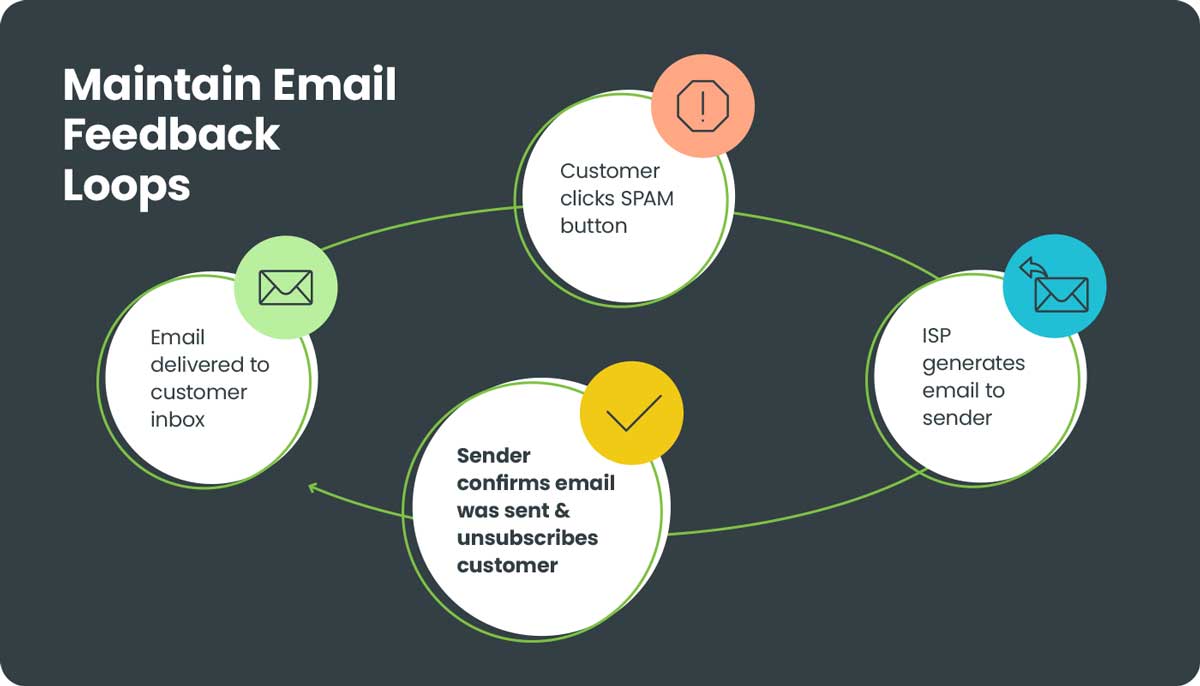
It’s critical to establish that feedback loop and then respond to the feedback your users are providing. This will help you maintain your reputation and help with high deliverability.
In crafting emails, it’s important to follow the rules detailed in the CAN-SPAM Act of 2003. This law sets commercial email rules, establishes commercial message requirements, gives recipients the right to unsubscribe, and explains the very tough penalties for violators.
The general rule of thumb is to be transparent and honest in all of your communications. Not a bad rule to live by, in general!
Here’s a list of the main requirements:
Charities raising money for good causes just need to be clear about their purpose. It will help your email deliverability and will protect your supporters from spammers, or even criminals.
The CAN-SPAM Act was enacted to protect U.S. consumers from unsolicited emails. But what if your nonprofit is emailing supporters in other countries?
Research their guidelines, whether you check out GDPR for the EU or CASL for Canada’s anti-spam legislation.
In general, be honest. Don’t act spammy! Make sure your subject lines don’t have misspellings or an overabundance of emojis and add a footer to all your emails with your address and contact info.
Importantly, make it very easy to unsubscribe or opt out. Periodically run re-engagement campaigns, in which you ask recipients who haven’t engaged with your emails if they’d like to keep receiving them. This can also be in your footer, so it’s easy to find.
And when someone wants to unsubscribe? Act promptly. They shouldn’t receive any more communication from you after that.
You’re in good hands with CharityEngine. We have spent years helping nonprofits of all sizes engage with their donors, raise more money, and increase their impact. We are your partner, and we’re here to help you every step of the way.
So what do we do on our side to help your email deliverability? We lean heavily on our technology. Here’s what’s on our checklist to help clients.
CharityEngine is responsible for:
Now let’s take a look at each of these.
How many times do you sign up for a newsletter, and before the process is complete, you must check your email and validate it? This helps in a few ways:
We recommend that email validation be standard practice for all nonprofits. Every time you get an email, validate the address. CharityEngine integrates with platforms such as ZeroBounce and NeverBounce so your emails are checked automatically when a new one is added.
When we implement CharityEngine for you, we will customize the configuration so this powerful technology fits your nonprofit perfectly. Some of the things we will do include:
Now that we’ve covered the responsibilities we each have, let’s talk about what happens after you prune your list and you remove people who haven’t engaged recently. (Good for you! Removing them is exactly what you need to do.)
But are you saying goodbye forever? Chances are good, or at least decent, that life got in the way of your donor remaining engaged. It’s often a break, not a breakup.
We recommend launching a re-engagement campaign to see if you can get those lapsed donors to come back. The best way to do this is through an email sequence, in which you send a series of emails based on how donors respond.
If they click a link, you send another email. If they click unsubscribe, you take them off your list permanently.
Here are some tips for a winning re-engagement campaign:
When someone really wants you to take a hike, you’ll know it, and you have to respect it instantly. This will help your technical reputation as well as your nonprofit’s brand reputation. It’s also just the right thing to do.

As we hope we’ve made clear, this is an important job that takes both of us working together. We eat and breathe email deliverability! We’ve published content and webinars that we can point you toward if you’d like more technical details, or you can pick up the phone and call us. CharityEngine’s expertise is here to benefit you.
